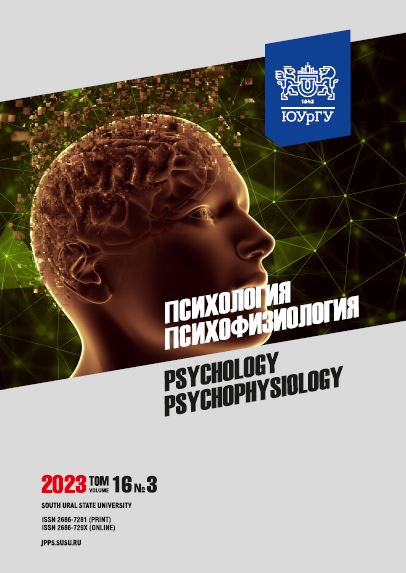Clinical and psychological interpretation of key patterns of eating disorders: analysis of domestic and foreign psychodiagnostic methods
Abstract
Background. Nowadays, the question of the assessment of eating behavior (EB) remains relevant. The analysis of publications has shown that most specialists use methods that are not adapted or standardized. Besides, the methods used, as a rule, allow specialists to state the presence or absence of a particular type of eating disorder without qualitative interpretation of the data. Aim: the paper presents an analysis of theoretical, methodological, and applied aspects of the most common methods of psychological diagnostics of eating behavior. Materials and methods. The study material involves complex methods published in Russian scientific literature, including 1) the Eating Behavior Questionnaire (U. Savchikova); 2) the Dutch Eating Behavior Questionnaire (T. Van Strien et al.); 3) the Eating Disorder Diagnostic Scale (Е. Stice); 4) Cognitive behavioral patterns for eating disorders (О.А. Sagalakova et al.); 5) the Eating Attitudes Test-26 (D.M. Garner et al.); 6) the Eating Disorder Inventory (D.M. Garner et al.). The abovementioned methods were studied inductively. Results. This battery of tests provides an opportunity to examine the presence and/or severity of the following patterns of eating behavior: food restrictions, nutritional control, binge eating, purging behavior, body image dissatisfaction, changes in eating motivation, and personal social factors of eating behavior. Each of these patterns possesses its own pathopsychological and/or psychophysiological ethiopathogenetic mechanisms. Conclusion. The battery of tests gives an opportunity to identify the presence of and evaluate basic changes in eating behavior. This battery doesn’t contain all the tests that identify all the selected patterns of EB. Besides, all these tests require additional qualitative interpretation of the data obtained. The development of a diagnostic method that estimates eating behavior disorder qualitatively and quantitatively seems promising.
Downloads
References
2. Михайлова А.П., Иванова Д.А., Штрахова А.В. Вопросы квалификации и психологической диагностики пищевого поведения в норме и при его нарушениях // Вестник Южно-Уральского государственного университета. Серия «Психология». 2019. Т. 12, № 1. С. 97–117. DOI: 10.14529/psy190110
3. Сагалакова О.А., Киселева М.Л. Опросник «Когнитивно-поведенческие паттерны при нарушениях пищевого поведения» // Клиническая и медицинская психология: исследования, обучение, практика: 2014. № 1(3). URL: http://medpsy.ru/climp/2014_1_3/article07.php (дата обращения: 21.02.23).
4. Нервная анорексия и нервная булимия: от истории к современности / Ю.Б. Барыльник, Н.В. Филиппова, М.А. Деева, М.А. Гусева // Российский психиатрический журнал. 2016. № 3. С. 36–45.
5. Шубина С.Н., Скугаревский О.А. Особенности результатов патопсихологического исследования больных нервной анорексией и шизофренией // Военная медицина. 2019. № 3. С. 88–92.
6. Психосоциальные факторы компульсивного переедания: мета-аналитическое исследование / А.А. Лифинцева, Ю.Ю. Новикова, Т.А. Караваева, М.В. Фомичева // Обозрение психиатрии и медицинской психологии. 2019. № 3. С. 19–27. DOI: 10.31363/2313-7053-2019-3-19-27
7. Брюхин А.Е., Онегина Е.Ю. Аффективные нарушения у пациентов с нервной анорексией и нервной булимией // Журнал неврологии и психиатрии им. C.C. Корсакова. 2011. № 1. С. 21–26.
8. Татаурова С.С. Актуальные проблемы исследования образа тела // Психологический вестник Уральского государственного университета. Вып. 8. Екатеринбург: Изд-во Уральского университета. 2009. С. 142–154.
9. Малкина-Пых И.Г. Терапия пищевого поведения. М.: Эксмо, 2007. 1040 с.
10. Загребаева О.Ю. Роль серотонинергической системы в развитии ожирения // Медицинские новости. 2016. № 4. С. 15–17.
11. Типы нарушений пищевого поведения / В.А. Дадаева, Р.А. Еганян, А.И. Королев, О.Т. Ким, О.М. Драпкина // Профилактическая медицина. 2021. Т. 24. № 4. С. 113–119. DOI: 10.17116/profmed202124041113
12. Лобыкина Е.Н., Салмина-Хвостова О.И., Симутина Н.С. Социально-экономические аспекты лечения больных с избыточной массой тела и ожирением // Здравоохранение Российской Федерации. 2008. № 3. С. 47–51.
13. Леонова Е.Н. Социально-психологические типы пищевого поведения // Вестник Удмуртского университета. Серия «Философия. Психология. Педагогика». 2017. Т. 27. Вып. 2. С. 174–181.
References on translit
-Copyright (c) 2023 Psychology. Psychophysiology

This work is licensed under a Creative Commons Attribution-NonCommercial-NoDerivatives 4.0 International License.



